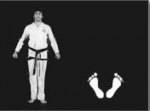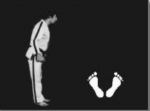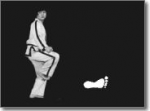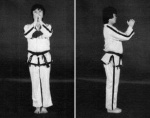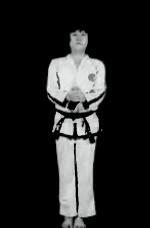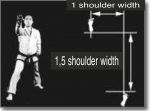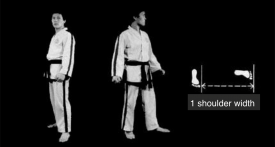Difference between revisions of "Stances"
m (Adapted semantic query) |
|||
| (3 intermediate revisions by the same user not shown) | |||
| Line 1: | Line 1: | ||
| − | '''<big> | + | '''<big>Here are all stances you learn in taekwondo, in the order of your level.</big>'''<br> |
[[English|Back to Welcome Page]] <br> | [[English|Back to Welcome Page]] <br> | ||
| Line 12: | Line 12: | ||
|format=embedded | |format=embedded | ||
}} | }} | ||
| − | |||
| − | |||
| − | |||
Latest revision as of 16:01, 19 March 2020
Here are all stances you learn in taekwondo, in the order of your level.
CHARYOT SOGI - Attention stance
This is the position used for attention, before and after exercise.
1. Feet form an angle of 45 degrees.
2. Drop fists down naturally. The elbows are slightly curved/bended.
3. The fists are clenched slightly.
4. The eyes look forward, just above the horizontal line.
Back to top of page - Back to Welcome Page
GUNNUN SOGI - Walking stance
This is a strong position, both front and rear feet are offensive and defensive.
Move one of feet forwards or backwards. The length between both feet should be the length of the shoulders.
A stand with a length longer than a one and a half shoulder width makes the movement slow and one is vulnerable to attack from the side, front or back.
Bend the front leg so that the heel in a straight aligns with the knee. The rear leg has to be completely stretched.
Distribute your body weight equally on both feet. Make sure the toes of the front foot pointing forward.
The toes of the back-foot must be pointed 25 degrees outwards When this is more than 25 degrees, the rear leg is more vulnerable to an attack from behind.
Tighten the muscles of both feet with the sense to bring them together.
Tighten the muscles of both feet with the sense to bring them together.
Back to top of page - Back to Welcome Page
JUNBI SOGI - Ready stance
Tae-kwon-do has many modes, which emerge in the patterns. The ready stance is not part of an action, but it is a position from which the student starts his pattern. This position is ideal for increasing the concentration.
Back to top of page - Back to Welcome Page
KYONG YE JASE - Greeting stance
This is the attitude and the movement that one must make when greeting the teacher, a fellow student, the jury and an opponent during competitions :
Bend the body 15 degrees forward.
Keep looking into the opponent's eyes.
Back to top of page - Back to Welcome Page
NARANI SOGI - Parallel stance
Spread the feet parallel to the shoulders' width.
The toes need to be pointing forwards.
Fists are 5 cm away from each other and on the height of the belt and 7 cm away from the body.
Back to top of page - Back to Welcome Page
NIUNJA SOGI - L-Stance
This position is widely used in the defense, but for the offensive stand also useful. The front foot is in place to give a kick.
It only needs a small displacement of body weight to Make a niunja sogi. Move one foot forward or backwards, so that the length between both feet is slightly less than about a shoulder width
There is pretty much a straight-line corner formed. It is recommended to move both feet to about 15 degrees to point inside, this gives better stability.
Bend the back leg until the knee is in a straight vertical line with the toes, ditto the front leg. Make sure that the hip stays in line with the inner knee joint. The body weight distribution is 70 percent on the back leg and 30 percent on the front leg.
ANNUN SOGI - Sitting stance
This is a very stable position for a lateral movement. This mode is also widely used for impact/punching exercises and for the leg muscles development.
One of the major advantages of this mode is that you can shift into walking stance without relocating the feet.
Spread one of the two legs to the side at a distance of one and a half shoulder width between the two toes.
Make sure the toes are pointing forward and the body weight is equally distributed on both legs.
Bending the knees outward, bending until the knee is over the ball of the foot
Tighten the thigh muscles and increase the strength of the legs by pulling the soles of the feet on the sides. Finishing a movement over the ground, push the chest and abdomen forward and push the hips backwards while the belly (muscle) is tightened.
Do not make the stance too wide. If you do, your speed and agility will dramatically decrease
stance may executable with a full face or side facing, both in attack and in defense.
The stance makes it possible to execute movements going straight forward or sideways, both in attack and in defense.
Back to top of page - Back to Welcome Page
GOJUNG SOGI - Fixed Stance
This is an effective mode to work out for an attack or go to the side. This position is equal to the short mode (niunja sogi) with the following exceptions:
- Body weight is evenly distributed on both legs.
- The distance between both feet is one and a half shoulder width.
When the right leg is forward, we call the position a right fixed stance and when the left leg is forward we call it a left fixed position.
The stand is always performed in a side facing.
Back to top of page - Back to Welcome Page
GUBURYO SOGI - Bending Stance
This position serves as a preparatory position for backward and lateral steps, generally defensive movements.
While standing on the right leg, there is a right flexed position, vice versa.
You can execute the position in full facing or side facing.
Back to top of page - Back to Welcome Page
MOA SOGI A - Closed Stance
A starting position in which with the feet are against each other. Possible executable with full face or a side facing.
Some of the 24 patterns, starting with this position.
Back to top of page - Back to Welcome Page
KYOCHA SOGI - X-Stance
This is a very well usable position to attack the front or the side of an opponent.
The stand is used in some cases for blocks, but generally it must stand as preparation for the move to the next manoeuvre.
- Cross one foot behind the other, the back foot is only half on the ground.
- Place the weight on the front leg.
When the body weight is on the right leg, we call it a right X-stance, and vice versa.
The stance possible executable with a full facing or side facing, both in attack and in defense.
Back to top of page - Back to Welcome Page
DWITBAL SOGI - Rear Foot Stance
This mode is mainly used for defense, but sometimes also for the attack.
The great advantage of this mode is that it can be passed to attacks with a kick without displacement of the body weight. The position is always performed with a side facing.
Make sure the knee of the back leg is pointing inwards.
- Move either foot forward or backward, so that a distance of one shoulder width arises between the two toes.
- Bend the back leg so far as the knee is over the toes. Place the bck heel just behind the heel of the front foot.
- Bend the front leg and keep light contact with the ball of the foot of the front leg.
- M Make sure the toes of the front foot are facing about 25 degrees inward and the toes of the back foot are facing approximately 15 degrees inward.
- The body weight is primarily on the back leg.
- Move either foot forward or backward, so that a distance of one shoulder width arises between the two toes.
Back to top of page - Back to Welcome Page
MOA SOGI B - Closed Stance
A position held with the feet down together. Possibly executable with full facing or a side facing.
Some of the 24 patterns, starting with this position.
Back to top of page - Back to Welcome Page
NACHUO SOGI - Low stance
The advantage of this stance is the ease with which one can extend the attacking tool.
It can also develop the leg muscles and is effective to adjust the distance to and from the target.
It is similar to the walking stance, though longer by one foot. It can be either full facing or side facing.
Back to top of page - Back to Welcome Page
MOA SOGI C - Closed Stance
A position held with the feet down together. Possible executable with full face or a side facing.
Some of the 24 patterns, starting with this position.
Back to top of page - Back to Welcome Page
SOOJIK SOGI - Vertical Stance
When the right leg stands forward, this position is a right vertical position and when the left leg stands forward, it is a left vertical position.
The stand is always performed with a half face.
Move one foot forward or backward, so that a distance of one shoulder width arises between the two big toes.
The distribution of body weight is 60 percent on the rear leg and 40 percent on the front leg.
Make sure the toes of both feet face approximately 15 degrees inward. Keep the legs straight.
